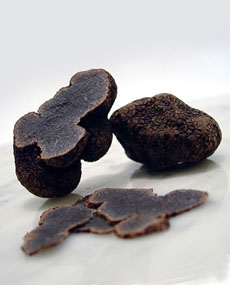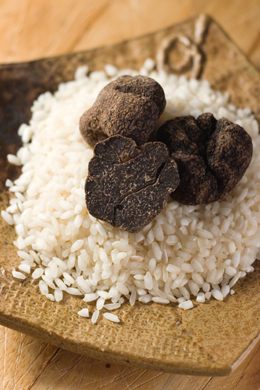For more about mushrooms, head to our Mushroom Glossary. This is Page 2 of a 12-page article. Click on the black links below to visit other pages.
Great Truffles, Not So Great TrufflesThe world’s finest truffles grow in France, Italy and Spain. The black truffles of Périgord are considered to be the best in the world due to their intense flavor and aroma (white truffle fans will argue this point), although the white truffles of Italy’s Piedmont region are even scarcer and thus far more costly. Truffles grow in temperate, moist climates throughout the world: They like warm, dry summers, cool, wet winters and alkaline (limestone) soil. China, Africa, New Zealand and Oregon have wild truffles, but they lack the aroma and flavor of the top varieties from France, Spain and Italy. In fact, more than half of the world’s varieties of truffle grow in Europe, but only five or so have savory qualities that command attention.
The top four sought-after varieties of fresh truffles are sky-high to begin with. The prices vary widely among varieties (from sky-high to astronomical), and from one year to the next, depending on the size of the harvests. Typically, the Melanosporum, the top black truffle, may cost five times more than the Brumale, Uncinatum or Aestivum—currently $1,000 to $2,100 a pound. The Magnatum white truffle is the costliest: It can be four times more expensive than the Melanosporum. Truffle ScamsA big problem is that as more and more people of means discover the pleasures of truffles, demand increases—but each year, fewer and fewer truffles are harvested. The crop in Périgord is estimated to be 25% of what it was a century ago. As a result, products are misrepresented: In France, agricultural agencies conduct lab analyses of black truffles to ensure they are legitimate French products and not inferior Chinese or Spanish black truffles that have been soaked in truffle juice to enhance their aroma. Lesser white truffles from other areas of Italy show up at the famed Alba market, attempting to pass as the great White Piedmont (or Magnatum or Alba) truffle, the world’s costliest truffle. (The Alba White Truffle Market is the only one where every truffle is tested to guarantee quality and type.) More pallid-tasting summer truffles are passed off to the unknowing as winter truffles. As with caviar (or anything else), if you don’t know what you’re buying, it’s easy to be duped...and the unknowing then wonder why they’ve just spent a small fortune on something that tastes no better than a supermarket mushroom. Continue To Page 3: Buying Truffles
Lifestyle Direct, Inc. All rights reserved. Images are the copyright of their respective owners.
|

The Nibble Blog
The Latest Products, Recipes & Trends In Specialty Foods
The gourmet guide you’ve been waiting for. New food adventures are served up daily. Check it out!

Food Glossary
Our Food Directories Are "Crash Courses" In Tasty Topics
Your ultimate food lover’s dictionary packed full of information and historical references. Take a look!

Food History
Let the journey begin!
Learn about the history Of 1,000+ Favorite Foods & Beverages Let’s explore the history of your favorie goods together.Let the journey begin!


